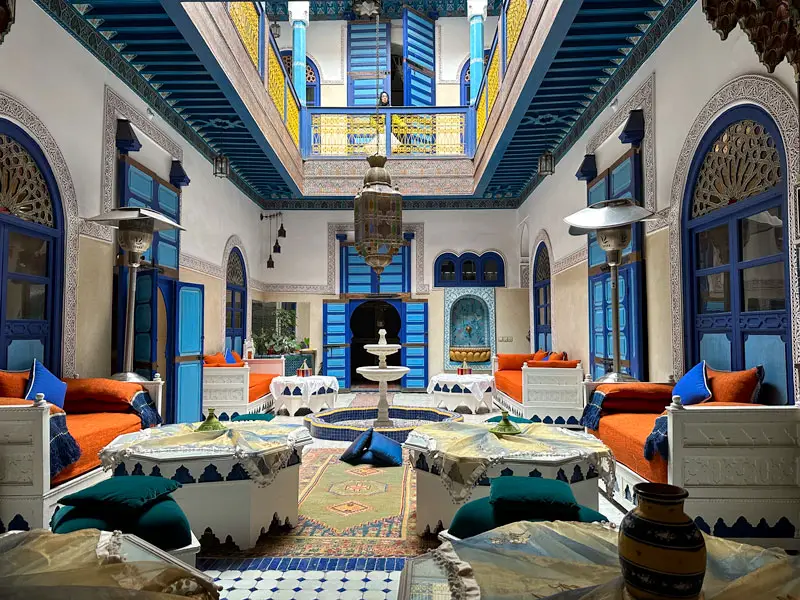Marrakech North Africa, the “Red City” of Morocco, is a place of enchantment and mystique, steeped in a rich tapestry of history and culture. But beyond the well-trodden tourist path, there lies a world of untold stories, hidden gems, and unforgettable experiences waiting to be discovered by travellers who immerse themselves in the real Marrakech.
We embrace authentic travel. Engaging with new cultures, traditions and people enriches our lives and broadens our views. To immerse ourselves in Marrakech North Africa, we stayed in a traditional riad within the walls of the medina and explored the city’s tangled streets on foot.

In this article, we share our authentic travel experience in Marrakech North Africa. This is our untold story of hidden gems and unforgettable experiences. Join us on our journey into the city’s lesser-known corners and discover the sights, sounds and experiences (good and bad!) that awaited us.
Preparing for our Authentic Travel Experience in Marrakech North Africa
For us, a big part of authentic travel is making our own travel arrangements independently. Before we travelled to Marrakech, we did 3 things:
- Prepared a Rough Itinerary of Things to See and Do in Marrakech
Wherever we travel, we always start by mapping out a rough itinerary of places to visit and possible things to see and do. After that, we research public transport links for our route and accommodation options.

To help us plan our visit to Marrakech, we purchased the Lonely Planet Guide. We find these guidebooks a useful starting point as they contain suggestions about where to stay and what to eat for a range of budgets. In addition to information about the main tourist sites, they also have suggestions about lesser-known places to visit.
- Decided Where to Stay in Marrakech
To immerse ourselves in the heart and soul of Marrakech, we decided to stay in a traditional Moroccan riad – a multi-storey house designed around a central courtyard with a fountain. We used Booking.com and Airbnb to search for suitable riads located in the heart of the medina so that we could absorb ourselves in local life.

It was also important for us to choose a riad that included breakfast. In our experience, smaller, locally owned guesthouses serve a traditional breakfast. This enables us to discover and experience local food each morning – an essential part of authentic travel.
Knowing the streets of the medina are like a labyrinth, we tried to find the location of our riad before we arrived in Marrakech. Google Maps struggled to pinpoint the exact address, so we phoned the riad for help. After kindly refusing their offer of a taxi transfer from the airport, we managed to get a rough location of the riad using nearby landmarks and a promise that we would be met by a ‘Guardian’ – the Doorman.
- Researched Public Transport from Marrakech Airport to the Medina
Another important feature of authentic travel is to travel like a local using public transport. In addition to experiencing how locals travel, public transport is cheap, and it allows us to spend more money on things like entry fees to historical sites and food. Of course, using public transport also means that we interact with local people as we often need to ask them for help with timetables, tickets and transport locations.

We always use internet searches and travel forums to start our public transport research. You might be surprised at how much information you can gather from your home! Before arriving in Marrakech, we knew that we could take either bus number 11 or 12 from the airport straight to the Marrakech medina.
Arrival in Marrakech
Marrakech’s modern airport is close to the city centre and is easily reached by public bus. After making sure our passports were stamped correctly, we asked a local for directions to the bus stop. Unsurprisingly, we were directed to the tourist shuttle bus!
Keen to avoid this, we eventually found the public bus stop via a very indirect route. Little did we know that we just needed to leave the arrivals door and walk straight ahead to reach the main road! However, one of the joys of authentic travel is getting lost and finding your way in another country.

For just 4 dirhams (40 cents), the bus dropped us off in a very central position between two of Marrakech’s most famous landmarks – the Koutoubia Mosque and the Place Jemaa El-Fna.
First Impressions of the Medina Marrakech
As we navigated the city’s busy main square (Place Jemaa El-Fna), our senses were overwhelmed. Unfamiliar sights and sounds competed for our attention as we tried to safely dodge cars, carts and horses in the hazy light.
Even though it was early in the morning, locals were crouched in front of baskets practising the ancient art of snake charming. The notes from the Pungi wind instrument echoed hypnotically across the square competing with the cries of juice sellers perched high above dazzling arrays of exotic fruits.

In a far corner of the Place Jemaa El-Fna, we entered the outskirts of the Marrakech souks. We soon found out that the medina is the most chaotic part of the city and an intense experience. Its narrow, confined streets were crowded with tourists and locals jostling for space.
Fumes lingered in the air from noisy motorbikes that somehow weaved their way through the chaos without incident. The smell of fumes was overpowering under the claustrophobic covered passageways, and we had to laugh about our efforts to reduce pollution by trading our diesel car for an unleaded model!
As we snaked our way through the alleyways, we hoped our printed map would lead us to our chosen riad in the depths of the medina. With no 4G (for a more authentic experience!) and not a street name in sight, we boldly continued past rows of narrow, cave-like shops sandwiched together as far as the eye could see.

Like Aladdin’s cave, the tiny shops were overflowing with treasures from tourist-pleasing brightly coloured leather Babouche shoes and decorative plates to healthy-looking cuts of meat and pharmaceutical products for the locals. Words of Arabic filled our ears as men dressed in traditional hooded Djellaba robes swept past, greeting acquaintances in their path.
Eventually, we found ourselves in the Place Ben Saleh with its low soft-coloured terracotta buildings and attractive 14th century mosque and intricate turquoise minaret. The small square was buzzing with life. Locals leisurely chatting outside small corner shops in traditional dress, men sorting through bric-a-brac on the back of a hand-pulled cart, and a butcher getting ready for the day with unsuspecting chickens clucking in cages behind him.

This part of the medina felt like another world. We felt like we were part of an action-adventure movie set as the noise of motorbikes filled the square and scattered locals and the occasional lost tourist. Whilst we waited, friendly locals offered to take us to our riad. However, our humble ‘guardian’ appeared as arranged. After exchanging a few simple greetings in Arabic and some words in French, he led us down an unassuming alleyway towards our home for the next few days.
Marrakech Riad
The riad did not disappoint. As the heavy door closed, the hustle and bustle of the medina was hushed and was replaced by the peace of a tiled central courtyard with mosaic fountain. Overhead hung a traditional Moorish lamp, beautiful inlaid wood joists and the inviting blue and yellow décor of the landings above. We were immediately transported to another time and immersed in the contrasting world of how the wealthy once lived.

On the rooftop, our host appeared with a smile and refreshments. She skilfully poured sweet-smelling peppermint tea from a traditional silver teapot into small patterned glasses and encouraged us to try some local sweet treats. As we took in the magnificent view across the medina rooftops, we were surrounded by the calls to prayer which echoed from mosque to mosque across the city.
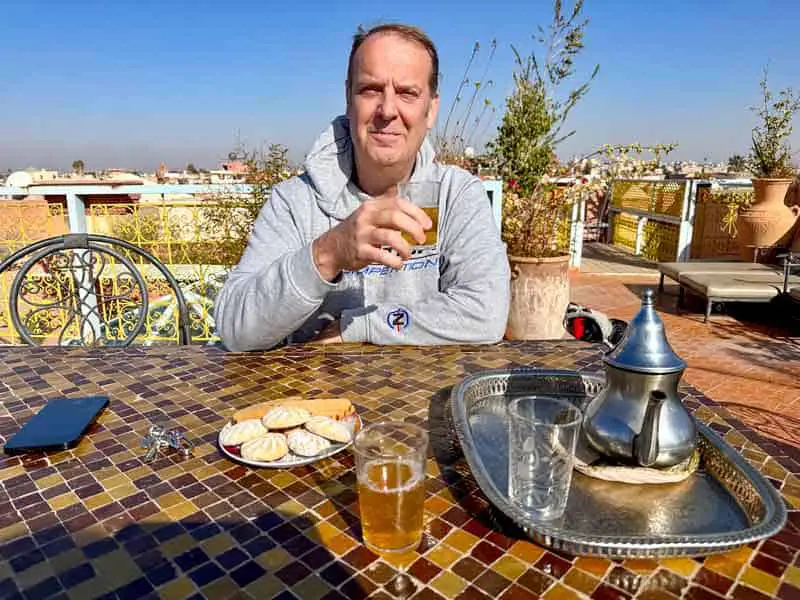
Exploring the Souks of Marrakech
One of the first things we did in Marrakech was to explore the many souks within the Marrakech medina. It was my first experience of a souk and I wasn’t sure what to expect.
From the Place Jemaa El-Fna, we were drawn into the busy Souk Semmarine that appeared quite tourist-orientated selling a little bit of everything including souvenirs, pottery, leather and metalwork goods.
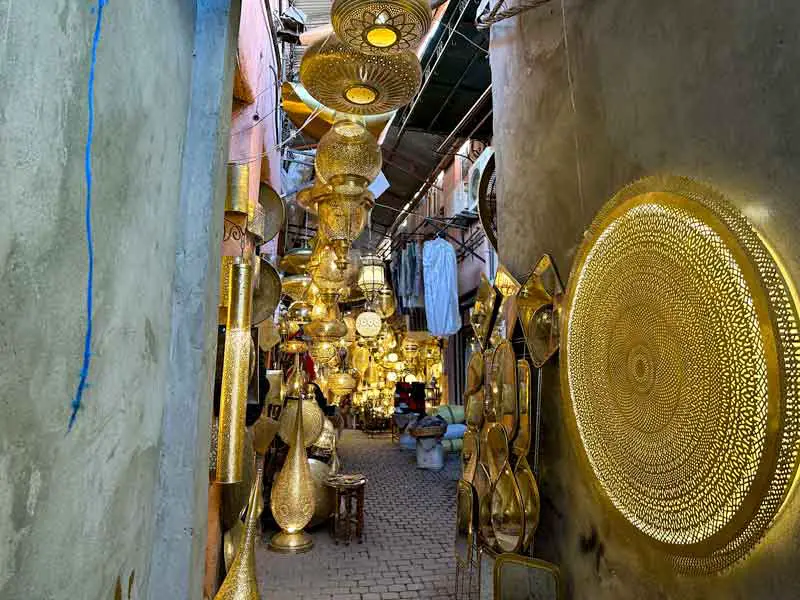
As we headed deeper into the souks, we get sucked into a never-ending warren of streets and alleyways that were overflowing with different merchandise. At first, the souks seemed like a jumble of shops. However, the further we walked, we realised that the souks were organised into districts with shops selling similar artisanal goods – leather, woodwork, metalwork, jewellery, textiles and carpets to name a few.
We took time to soak up the atmosphere and to admire the architecture of buildings within the souks. Amidst the shops, we discovered detailed mosaic facades, ornate arches and hidden squares. Of course, you can’t visit the souks without haggling, as this is an important part of Moroccan culture. After declining the first prices offered with a smile, we managed to get a fair price on some local artisanal goods.

Of course, it’s easy to get lost in the winding streets of the souks. We embraced this as it helps make a travel experience more authentic. We love to discover new things by being adventurous and not always knowing where we are going!
Usually, we love to ask locals for help when we get lost. However, in Marrakech it soon became apparent that some locals in the souks were less trustworthy than others. To avoid being sent round in circles, returned to the Place Jemaa El-Fna or taken to the Tanneries, we stopped accepting ‘help’ from locals. In the end, we figured out that one way of avoiding being stuck in a dead end was to stick to the streets with motorbike traffic.
By chance, we stumbled on the Place des Épices in the Rahba Kedima square with its mountains of colourful sweet-smelling spices, sacks of dried flowers that spilled onto the square, and the more curious sight of tiny live tortoises.

As we walked past, friendly spice sellers encouraged us to sample their goods and happily explained the health benefits of various spices and oils. A sniff of menthol crystals certainly cleared our sinuses for the day and Olivier is still chewing on his free liquorice root stick!
By exploring the souks on foot, we found many public hammam bath houses. Some were for men only and some catered for women. The locals running the hammams were very helpful and were willing to show us inside and describe the services they offered. Next to one hammam, we discovered its ‘engine room’ and met the man who was keeping the hot water running. His workplace was clearly his home as well, but he welcomed us in nevertheless and shared how everything worked.

Uncovering Marrakech’s Cultural Gems
Undoubtedly, the souks are one of Marrakech’s cultural highlights. However, within the Marrakech medina we explored many other historical sites that gave us an insight into the city’s past and other authentic cultural experiences.
The Koutoubia Mosque
The Koutoubia Mosque was the first place we visited on our arrival in Marrakech. As the largest mosque in Marrakech and its most famous landmark, the Koutoubia Mosque dominated the city’s skyline with its 250-foot-high minaret. We could even see it from the rooftop terrace of our riad which made for some great sunset pictures.

However, only Muslims can enter the Koutoubia Mosque. We happened to visit on a Friday when the doors are open for prayers, but this felt fairly intrusive, so we didn’t like to linger out of respect. Certainly, the square in front of the mosque and the Koutoubia Gardens behind were peaceful places to spend time away from the hectic medina.
Madrasa Ben Youssef (Ibn Youssef School)
One way of gaining an insight into Marrakesh’s Islamic heritage is to visit the Madrasa Ben Youssef. This 14th century building was once an Islamic school and is located in the narrow streets of the northern medina.

A serene atmosphere permeates the Madrasa Ben Youssef, and it still feels like a place for quiet reflection. The inside of the building is a beautiful example of Moroccan architecture and demonstrates the skill and craftmanship of artisans at the time. It was one of my favourite places to visit in Marrakech.

The highlight of the Madrasa Ben Youssef was the central courtyard with its marble tiled floor and sunken pool that led to an ornate prayer hall. Around the courtyard were covered walkways with striking geometric tiled patterns. Whilst overhead, galleries of arched windows were set within delicate lace-like designs below panels of intricate carved wood.
The Bahia Palace
A visit to the well-preserved Bahia Palace gave us a different perspective of life in Marrakech. Built in the 19th century, the Bahia Palace was designed to be the greatest palace at that time for its imperial residents.

As we walked through the empty rooms of the palace and its impressive courtyard, we were immersed in the splendour of Islamic and Moroccan architecture. The rooms were adorned with colourful tiled mosaics, early examples of stained glass, intricately carved woodwork and painted wooden ceilings.

Exploring the palace certainly allowed us to step into a world of beauty and tranquillity, and to experience first-hand the grandeur and elegance of Moroccan palatial life. However, it was a shame that there were no historic artefacts on display.

The Kasbah District of Marrakech – Saadian Tombs & Hidden Gem
To experience a different part of the Marrakech medina, we headed to the Kasbah neighbourhood that was once the citadel and royal palace complex of the city.

Our first stop was the Saadian Tombs that we discovered behind a very unassuming wall. In fact, we learned that the royal Saadian tombs were deliberately hidden behind a wall by one of the Sultans and lay undiscovered until 1917. Although the Saadian Tombs are part of Marrakech’s UNESCO World Heritage Site, they are still unmarked today.

The lavish tomb complex was another architectural jewel giving an insight into Marrakech’s royal past. The complex mosaic walls and floors have been painstakingly restored to their former splendour. The Chamber of the 12 Pillars is resting place to Sultan Al Mansour and his sons and was an impressive sight.
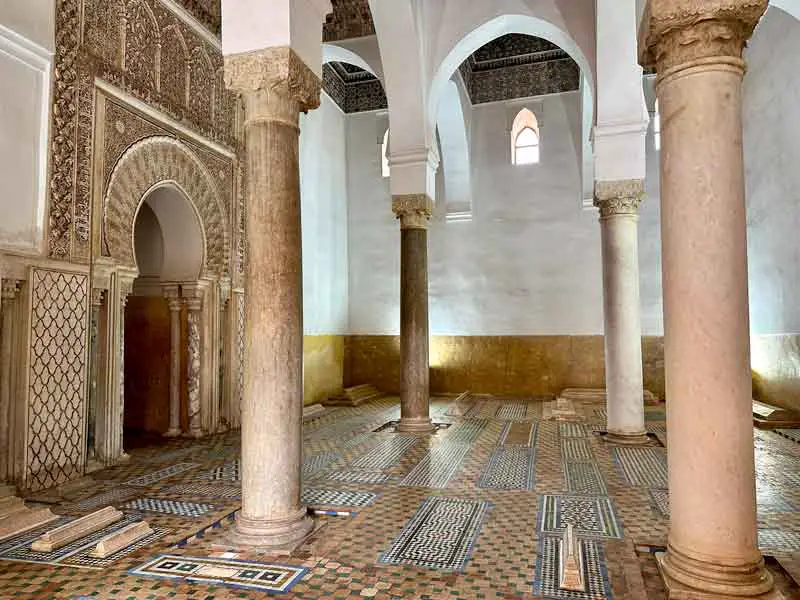
After visiting the Saadian Tombs, we meandered around the backstreets of the Kasbah Marrakech district. This area was less busy than the medina and had more of a village atmosphere. We soon discovered (from a guard on duty) that the King of Morocco’s Royal Palace (Dar al-Makhzen) still occupies the eastern part of the Kasbah. We took time to explore the quiet maze of terracotta colour residential streets and stumbled on a hidden gem – a bustling market with locals buying colourful fruit and veg from simple cloths on the floor.
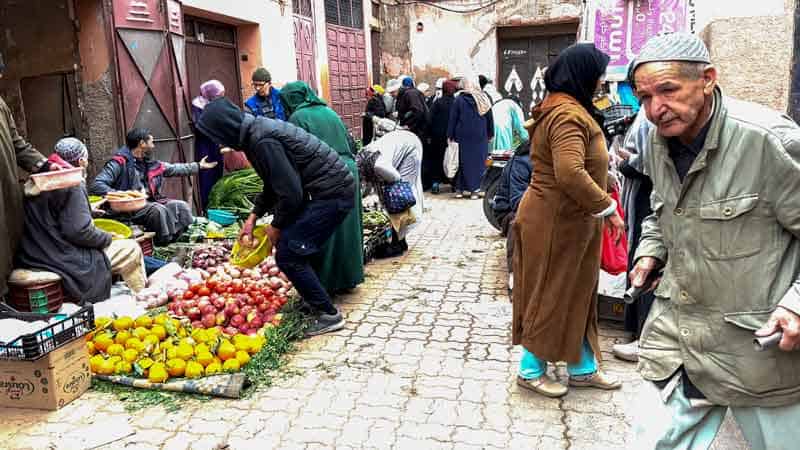
Mellah District of Marrakech
Not far from the Kasbah district is the Mellah district. This is the Jewish Quarter of Marrakech situated close to the Bahia Palace. However, very few Jewish people live here today. As we walked around, it was clear that this neighbourhood had a different style of architecture with taller houses with balconies, but it also had a different atmosphere.
Originally, we had plans to visit the Mira Jewish Cemetery, but locals had other intentions and kept directing us to the Lezama Synagogue or back to the Mellah market. However, we stayed long enough to get a feel for this area, but it didn’t really appeal to us and if felt more unsafe than other areas of the medina.
Tanneries
Before we arrived in Marrakech, we were warned not to follow locals in the medina as there is a well-known scam to lead tourists to the Tanneries. As we explored the souks, we were regularly approached by men trying to persuade us to visit the Tanneries. After spending days politely refusing their requests, we too fell victim to the scam.

This is how it happened … We had deliberately set out one morning to find the Tanneries ourselves. We headed in what we thought was the right direction and even asked two police officers for directions. Funnily enough, their advice was to head into the souks, and someone would soon show us!

As we continued, a local suggested that we could follow his friend who worked in the souks. On the surface, this offer seemed more genuine. After all, we just wanted to find our way. However, we ended up in the depths of the Tanneries. Before we knew it, we were subtly introduced to the Guardian of a Tannery and ushered inside for an informative tour.
Undoubtedly, we were presented with a unique sight that gave us a real insight into the laborious leather-making process. Men were scraping, washing and dying hides in baths of murky looking water. Scattered around were hides drying in the sunshine. Fortunately, we had been given bundles of mint to mask the putrid smell.

However, it soon became apparent that this was not a free visit! After being taken to a cavernous shop selling every type of leather goods, the Guardian of the Tannery was waiting for us and demanded money. The friendly man who welcomed us to his Tannery had changed quickly. This was not a pleasant experience, as his manner was threatening and there were no other tourists in sight.

The bottom line is that the Tanneries were an interesting and educational place to visit but I would avoid going here. It’s a shame that the locals running them operate in a misleading and menacing way. What they don’t seem to realise is that tourists would be happy to pay for a visit if they were open rather than underhand.
Jardin Majorelle
After several intense days spent exploring the medina, we headed outside of its walls to find the Jardin Majorelle.

On foot, we left the Place Jemaa El-Fna and followed the rampart walls towards the Jardin Majorelle. As soon as we left the medina, we were transported back to the present with more familiar sounds and sights. Dark, claustrophobic passages were replaced by wide, airy boulevards and lush green gardens.

Outside the Bab Doukkala gate that leads to the medina, we stumbled across an extraordinary sight. The square was filled with tradesmen of every type waiting for a job. Behind their bicycles were carts laden with the tools of their trade – ladders, painting equipment and plumbing gear.
As we walked to the Jardin Majorelle, we discovered the more modern side of Marrakech. We noticed more women going about their daily routine and the streets were lined with modern-looking restaurants, shops and luxury spas. A complete contrast to the medina.

The Jardin Majorelle itself was an oasis of calm away from the hectic life within the medina walls. Architectural exotic plants and tall palm trees offered a tranquil, shady retreat. Yves Saint Laurent’s Garden is certainly a living design and the plants look stunning against the backdrop of bright blue buildings, pergolas and planters. The Jardin Majorelle is an absolute paradise for plant lovers and photographers alike.

Nestled amongst the desert plants is the stunning Art Deco house where Yves Saint Laurent and Pierre Bérgé lived together. Today this beautiful building is a museum that you can visit. Within the grounds of the Jardin Majorelle, there is also a memorial.

Indulging in Moroccan Cuisine
We love eating authentic food when we travel! One of the best ways of immersing ourselves into a different culture is to try different local food specialties and this usually starts at breakfast!
Traditional Moroccan Breakfast

Every morning, we were served a delicious traditional breakfast in our locally owned riad. Needless to stay, sweet peppermint tea accompanied Moroccan Khobz bread, Msemmen (a type of flat bread), Baghrir (Moroccan pancakes), olive oil (instead of butter), honey, jam, spices, spreadable cheese, black olives, omelette, croissants, coffee and freshly squeezed orange juice. This breakfast feast was a great way to start a day of walking and sightseeing!
Street Food in Place Jemaa El-Fna at Night
Eating in the Place Jemaa El-Fna at night was a memorable experience for the ambience, not the food! At dusk, the square comes to life with street performers, exotic animals, musicians and pop-up food stalls.

One by one, local food vendors attempted to persuade us to eat at their stall with a smile, a joke, their menu and stand number. By the end of the night, we had quite a collection! Although prices were reasonable, our vegetable tagine featured mainly carrots, but the atmosphere was a unique experience.
Authentic Local Specialties in the Souks
To experience more authentic food, we headed to the back streets of the souks. Here we discovered locals crowded around small street food stands. Nearby, we stumbled upon the restaurant Chez Bakchich with displays of fresh vegetables and bubbling tagines.

After a climb up a shaky spiral staircase, our heads emerged on the rooftop terrace with views over the medina. Our friendly hosts were happy to share their recommendations of what to eat including Tanjia and Prune Tagine.

Before eating, we were welcomed with freshly brewed sweet peppermint tea. As is customary, the peppermint tea was poured at height from a metal teapot into a small, patterned glass and then returned to the pot before serving. The ceremony of preparing tea is clearly an art form and was an authentic cultural ritual that we were glad to experience whilst in Marrakech.

When the food arrived, it did not disappoint. The sweet and sticky Prune Tagine was served in a traditional cone-shaped clay dish. The tagine was delicious with melt in your mouth meat and plump, juicy prunes. We discovered that Tanjia is a traditional Marrakech dish made by slowly cooking lamb with spices in a terracotta amphora pot over the coals serving the hammam. The meat was so tender that it fell off the bone and was extremely tasty.

Traditional Sweet Pastry Treats
One of the other delights of eating in Marrakech was trying the intriguing sweet pastry treats from local vendors in the souk passageways. The pastries were extremely rich, often flavoured with different ground nuts (including pistachio), honey, dates, orange blossom, rose water and cinnamon. Our favourites included:
- Baklawa – sweetened ground nuts between layers of pastry.
- Fekkas – crispy, toasted slices with almonds that resembled Italian Biscotti.
- Makrout – crumbly pastry made with semolina, with honey glaze decorated with a diamond pattern and filled with a sweet date paste.
Final Thoughts on Authentic Travel in Marrakech …
Our visit to Marrakech truly gave us a first-hand experience of Moroccan culture, cuisine, history and architecture. By staying in a locally run riad in the heart of the medina, we were immersed in the sights and sounds of daily life. Friendly locals helped us to learn about traditional food in Marrakech and introduced us to new dishes, whilst others tried to mislead us.

The historic sites of Marrakech gave us an insight into the city’s past and showed us the beauty of Islamic and Moroccan architecture. Above all, exploring the city on foot allowed us to soak up the unique sights, sounds and atmosphere of Marrakech.

Our journey in Marrakech was a unique and authentic travel experience. It opened our eyes to a different culture and provided us with memorable experiences that taught us new things. Travel really is the best educator!

